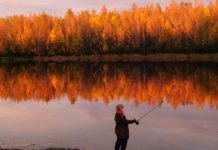Large brown trout landed using a creeper.
The Creeper – Early-Season Trout Nymph Pattern
By Martins Langlands
I remember well the first time I glanced at this insect. My reaction was one of both shock and amazement. At one and a half inches long with spiky projections running along each side of the body the creeper is one of the largest aquatic insects preyed upon by trout in rivers. Its powerful jaws give it a fearsome appearance.

The creeper’s shiny black wing case gives it an armoured appearance.
Creepers are called by many names-such as toe biters (because of their strong biting jaws), Alderfly, Dobsonfly and to the scientists the Latin name Archichauiiodes diversus. My article will focus on the creeper which is the larval stage of the Dobsonfly. The adult Dobsonfly is seldom seen.
However, it is quite spectacular with its large lacy wings. Creepers live underwater amongst the stones and then after a year change (metamorphose) into the adult Dobsonfly (the change from creeper to Dobsonfly is similar to the change from a caterpillar to a butterfly). The Dobsonfly emerges from the water and mates to ensure the next generation of creepers in the river.
The creepers live in most South Island streams, preferring a river bottom of rocks and stones. They feed upon smaller nymphs between the stones, especially mayflies. Often when river levels rise into a state of fresh or flood the creepers get dislodged from the stones and drift in the current. This factor combined with their large size make them very available and visual to feeding trout.
Creepers vary in colour, each insect having two colour tones, often a black head and grey abdomen. Along each side are spiky gills (refer to photo). The creepers spiky gills are characteristic and fly patterns imitating Dobsonflies should imitate this distinctive feature.
I have seen many successful creeper patterns. The essence of tying fish catching nymphs is to tie a rough impressionistic pattern as opposed to super realistic ties. To do this the tyer must decide the most important features on the natural, in this case the creeper’s most important features are:
1. Elongated body.
2. Two-tone colouration.
3. Spiky gills.
4. Shiny black wing case.
Accordingly, I have developed a creeper nymph pattern using the following materials:
Hook: size 10, 8, 6 larval hook.
Tail: Grey goose blots (two).
Abdomen: Grey dubbing ribbed with copper wire.
Thorax: Black dubbing.
Wingcase: Black raffia.
It is most important to use lead wire to sink the creeper pattern When placing the dubbing on the hook tease it out to look shaggy. The more the dubbing is teased out the better the imitation. Teasing out the dubbing gives the pattern a broken profile imitating the gills.
The creeper is an excellent early season pattern most suited to the upstream indicator method. The creeper pattern I have outlined in my article is effective early season when the river’s flow is frequently swollen and swift (from snow melt in the spring). The larger size of the toe biter pattern also makes it visible to trout in discoloured water.
Guided NZ fly fishing and fly fishing lessons in the South Island of New Zealand with professional fly fishing guide, Martin Langlands – Troutlands
Dobsonfly Larva DVD – Dobsonfly Larva an anglers act of inquiry
Credit: Source link






























